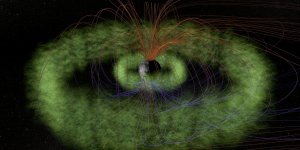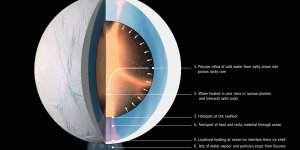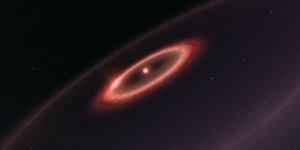Space News

Scientists have long known that solar-energized particles trapped around the planet are sometimes scattered into Earth’s upper atmosphere where they can contribute to beautiful auroral displays. Yet for decades, no one has known exactly what is responsible for hurling these energetic electrons on their way. »

Heat from friction could power hydrothermal activity on Saturn's moon Enceladus for billions of years if the moon has a highly porous core, according to a new modeling study by European and U.S. researchers working on NASA's Cassini mission. »

The ALMA Observatory in Chile has detected dust around the closest star to the Solar System, Proxima Centauri. These new observations reveal the glow coming from cold dust in a region between one to four times as far from Proxima Centauri as the Earth is from the Sun. »

An international team of astronomers discovered an exoplanet, called NGTS-1b, revolving around M-dwarf star NGTS-1, that the team said does not fit existing notions of how stars and planets form. »

NASA's Hubble Space Telescope has found a blistering hot planet outside our solar system where it "snows" sunscreen. The problem is the sunscreen (titanium oxide) precipitation only happens on the planet's permanent nighttime side. »

In partnership with an international team, a group of Brazilian astronomers discovered the existence of a ring around a dwarf planet near Pluto, similar to those of the giant Saturn. The ring revolves around Haumea, located in the so-called Kuiper Belt. »

Powerful solar eruptions could electrically charge areas of the Martian moon Phobos to hundreds of volts, presenting a complex electrical environment that could possibly affect sensitive electronics carried by future robotic explorers, according to a new NASA study. »

Researchers with NASA’s Cassini mission found evidence of a toxic hybrid ice in a wispy cloud high above the south pole of Saturn’s largest moon, Titan. »

For the first time, NASA scientists have detected light tied to a gravitational-wave event, thanks to two merging neutron stars in the galaxy NGC 4993, located about 130 million light-years from Earth in the constellation Hydra. »

The discovery of evidence for ancient sea-floor hydrothermal deposits on Mars identifies an area on the planet that may offer clues about the origin of life on Earth. »

Observations made with the Atacama Large Millimeter/submillimeter Array (ALMA) and ESA’s Rosetta mission, have revealed the presence of the organohalogen Freon-40 in gas around both an infant star and a comet. »

The spectacular planetary nebula NGC 7009, or the Saturn Nebula, emerges from the darkness like a series of oddly-shaped bubbles, lit up in glorious pinks and blues. »

NASA scientists have found evidence that Mars’ crust is not as dense as previously thought, a clue that could help researchers better understand the Red Planet’s interior structure and evolution. »

A thrilling epoch in the exploration of our solar system came to a close today, as NASA's Cassini spacecraft made a fateful plunge into the atmosphere of Saturn, ending its 13-year tour of the ringed planet. »

Hubble Space Telescope has observed a planet outside our solar system that looks as black as fresh asphalt because it eats light rather than reflecting it back into space. »

NASA's Cassini spacecraft is on final approach to Saturn, following confirmation by mission navigators that it is on course to dive into the planet's atmosphere on Friday, Sept. 15. »

Scientists on NASA's Juno mission have observed massive amounts of energy swirling over Jupiter's polar regions that contribute to the giant planet's powerful auroras - only not in ways the researchers expected. »

The sun emitted two significant solar flares on the morning of Sept. 6, 2017. »

Astronomers have found new evidence for the existence of a mid-sized black hole, considered the missing link in the evolution of supermassive black holes. »

Phenomena across the Universe emit radiation spanning the entire electromagnetic spectrum — from high-energy gamma rays, which stream out from the most energetic events in the cosmos, to lower-energy microwaves and radio waves. »

ALMA has been used to detect turbulent reservoirs of cold gas surrounding distant starburst galaxies. »

Scientists have discovered the strongest evidence to date for a stratosphere on a planet outside our solar system, or exoplanet. »

New research suggests up to half the matter in the Milky Way – including the atoms that make up all of us – could have come from outside our own galaxy, much more than scientists previously thought. »

NASA scientists have definitively detected the chemical acrylonitrile in the atmosphere of Saturn’s moon Titan, a place that has long intrigued scientists investigating the chemical precursors of life. »

Using new observations from ESO’s VLT Survey Telescope, astronomers have discovered three different populations of young stars within the Orion Nebula Cluster. »

Images of Jupiter’s Great Red Spot reveal a tangle of dark, veinous clouds weaving their way through a massive crimson oval. »

Astronomers at the University of Cambridge in England announced the discovery of a dwarf star, known as EBLM J0555-57Ab, which is slightly bigger than Saturn and smaller than Jupiter. It was found using data from an array of automated telescopes called the Wide Angle Search for Planets. »

NASA has achieved a significant milestone in its effort to make supersonic passenger jet travel over land a real possibility by completing the preliminary design review (PDR) of its Quiet Supersonic Transport or QueSST aircraft design. »

Arp 299 is a system located about 140 million light years from Earth. It contains two galaxies that are merging, creating a partially blended mix of stars from each galaxy in the process. »

By combining the power of a "natural lens" in space with the capability of NASA's Hubble Space Telescope, astronomers made a surprising discovery. »

NASA’s Kepler space telescope team has released a mission catalog of planet candidates that introduces 219 new planet candidates, 10 of which are near-Earth size and orbiting in their star's habitable zone, which is the range of distance from a star where liquid water could pool on the surface of a rocky planet. »

A new study suggests that most global climate models may underestimate the amount of rain that will fall in Earth’s tropical regions as our planet continues to warm. »

Astronomers at the Ohio State University, Columbus, revealed the discovery of an exoplanet, named KELT-9b and according to the university's astronomy professor Scott Gaudi, it is "the hottest gas giant planet that has ever been discovered". »

ALMA has observed stars like the Sun at a very early stage in their formation and found traces of methyl isocyanate — a chemical building block of life. »

Early science results from NASA’s Juno mission to Jupiter portray the largest planet in our solar system as a complex, gigantic, turbulent world, with Earth-sized polar cyclones. »


